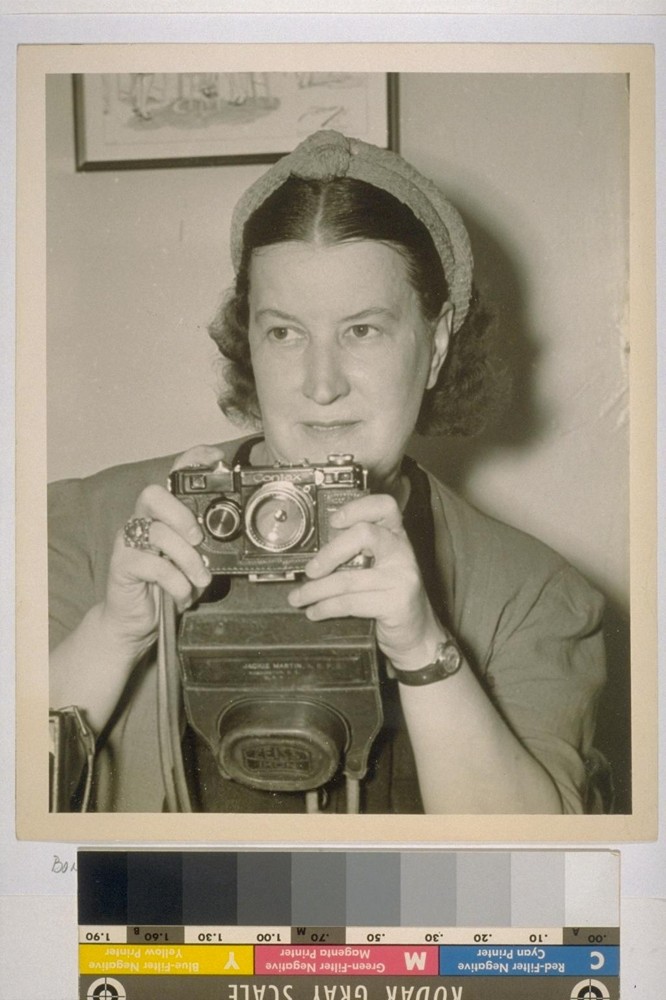
Thérèse Bonney,Thérèse Bonney with Camera © The Regents of the University of California, The Bancroft Library, University of California, Berkeley. This work is made available under a Creative Commons Attribution 4.0 license.
Thérèse Bonney (1874 – 1978)
American Photographer and War Correspondent
Thérèse Mabel Bonney (1894-1978) was an American-born photographer and war correspondent, renowned for her powerful documentation of World War II and its effects on civilian populations. Born in Syracuse, New York, she spent her early years in California and later pursued an extensive academic career, earning degrees from prestigious institutions including the University of California, Berkeley, Harvard, Columbia, and the Sorbonne in Paris.
Initially aspiring to an academic career, Thérèse’s experiences in Europe shifted her focus towards fostering cultural relations between the United States and France. She became deeply involved in journalism and photography, establishing the first American illustrated press service in Europe. Her modelling career in the 1920s also brought her acclaim as the “most perfect da Vinci model in the world,” and she developed close ties with many leading artists and intellectuals of the era (Robertson, 1976). Thérèse’s photographic career took off during World War II when she captured the harsh realities of conflict, especially its impact on civilians and children. Her work during the Russo-Finnish War, where she was the only photojournalist present, earned her international recognition and Finland’s highest honour, the Order of the White Rose. She was later appointed the official photographer of the French military headquarters during the Battle of France, where she produced some of the most comprehensive visual records of the war.
Europe’s Children
Her most famous work, the book and exhibition Europe’s Children, highlighted the suffering of war-displaced children and was instrumental in influencing global humanitarian efforts, including the establishment of UNICEF. Despite her significant contributions, Thérèse’s legacy has often been overlooked compared to her contemporaries. She continued to work into her later years, focusing on issues affecting the elderly and continuing her advocacy for humanitarian causes.
Thérèse’s journey as a photographer and war correspondent is particularly notable not just for the breadth of her work but also for the distinctive perspective she brought to her subjects. Unlike many of her contemporaries, Thérèse was deeply invested in the cultural and human dimensions of war, focusing less on the military actions and more on the lives irrevocably altered by conflict. Her images were not just snapshots of destruction but profound narratives of resilience, survival, and the quiet dignity of ordinary people caught in extraordinary circumstances. This empathetic approach is what made her work so compelling, particularly in her documentation of Europe’s children during World War II. Thérèse’s photographs are a testament to her ability to capture the vulnerability of children who had been uprooted by war, making visible the emotional and physical toll of global conflict on the youngest and most innocent victims. Her focus on the humanitarian consequences of war helped shift public discourse, drawing attention to the need for international relief efforts, and arguably influencing the eventual establishment of UNICEF.
Her Legacy
Beyond her work in war photography, Thérèse’s legacy is also marked by her efforts to bridge cultural divides through art and journalism. She was a pioneer in recognising the power of visual media as a tool for international diplomacy and cultural understanding. By establishing the Bonney Service, she created a transatlantic channel through which American audiences could engage with European culture, art, and politics, long before the age of instant global communication. Her friendships with influential artists, writers, and intellectuals of the time further positioned her as a key figure in the cultural exchange between the United States and France. Moreover, Thérèse’s passion for food and her meticulous research on cheese, which she referred to as “Project Fromage,” exemplify her commitment to documenting not just the grand events of history, but also the everyday life and traditions that shape a culture. This holistic approach to her work, where war photography, cultural journalism, and even culinary exploration were all part of a broader mission to foster understanding and empathy across borders, sets Thérèse Bonney apart as a truly remarkable figure in the history of photojournalism and cultural diplomacy. Thérèse passed away in Paris on January 15, 1978, leaving behind a rich legacy of photographic work that remains a valuable historical resource.
By Ruby Mitchell

Thérèse Bonney © The Regents of the University of California, The Bancroft Library, University of California, Berkeley. This work is made available under a Creative Commons Attribution 4.0 license.
References
- Robertson, Nan. “In a Life of Firsts, She Has Few Regrets.” The New York Times 25 July 1976.
- Gourley, Catherine. War, Women, and the News: How Female Journalists Won the Battle to Cover World War II, (2007).
- Oinas-Kukkonen, Henry. “Miss Bonney Reporting from the Arctic Front.” In Reporting World War II. Fordham University Press, 2023. https://doi.org/10.5422/fordham/9781531503093.003.0004.
- “THERESE BONNEY and Photographing History.” International Women’s News 36, no. 5 (1942): 90.











